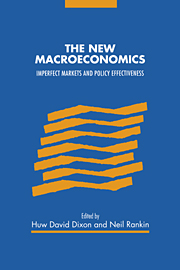Book contents
- Frontmatter
- Contents
- List of contributors
- Preface
- Acknowledgements
- Introduction
- Part I Overviews and perspectives
- Part II Goods market imperfections
- 4 Optimal labour contracts and imperfect competition: a framework for analysis
- 5 Market power, coordination failures and endogenous fluctuations
- 6 Macroeconomic externalities
- Part III Labour market imperfections
- Part IV Financial market imperfections
- Part V Nominal rigidities and bounded rationality
- Bibliography
- Index of authors
- Index of subjects
5 - Market power, coordination failures and endogenous fluctuations
Published online by Cambridge University Press: 13 October 2009
- Frontmatter
- Contents
- List of contributors
- Preface
- Acknowledgements
- Introduction
- Part I Overviews and perspectives
- Part II Goods market imperfections
- 4 Optimal labour contracts and imperfect competition: a framework for analysis
- 5 Market power, coordination failures and endogenous fluctuations
- 6 Macroeconomic externalities
- Part III Labour market imperfections
- Part IV Financial market imperfections
- Part V Nominal rigidities and bounded rationality
- Bibliography
- Index of authors
- Index of subjects
Summary
Introduction
Imperfect competition has become one of the main ingredients of the so-called ‘New Keynesian economics’. Much recent work has emphasized Keynesian features of imperfectly competitive macroeconomic models, belonging either to the Cournotian tradition, as in Hart (1982), or to one of the monopolistic competition brands, corresponding to the Chamberlinian framework of Dixit and Stiglitz (1977) (Weitzman, 1985; Blanchard and Kiyotaki, 1987), or to Hotelling's spatial model (Weitzman, 1982). A somewhat paradoxical aspect of part of this literature is that it actually appears quite unkeynesian, not so much because Keynes himself paid little attention to imperfect competition, but essentially because some of its results, concerning in particular unemployment or the response to aggregate demand shocks, depend either on union power, or on small adjustment costs (‘menu costs’) and ‘nearly rational’ behaviour of price-setting agents and thus in a sense come back to ‘classical’ explanations, in terms of wage and price rigidities or frictional phenomena.
We do not want to deny the relevance of such explanations. We propose to explore in this chapter only some consequences of firms' monopoly power, in a context of full rationality, complete price flexibility, without adjustment costs and in the absence of exogenous shocks. Since we conform to the Keynesian priority given to the product market relatively to the labour market, and since it is the output market power that we want to emphasize, we shall (unrealistically) assume perfect competion in a homogeneous labour market.
- Type
- Chapter
- Information
- The New MacroeconomicsImperfect Markets and Policy Effectiveness, pp. 94 - 138Publisher: Cambridge University PressPrint publication year: 1995
- 9
- Cited by

